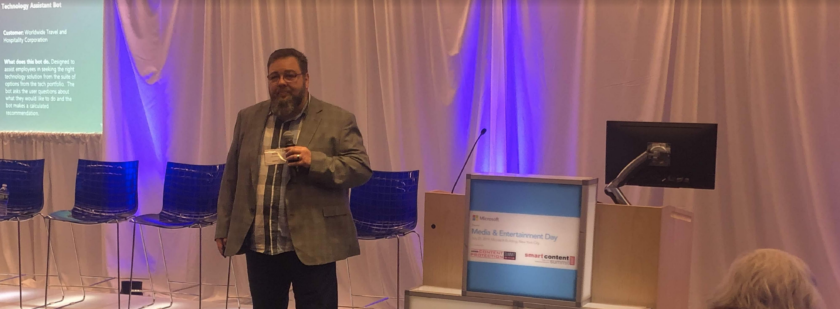Connections

LiveTiles: Bots Should Reduce the Workload, Not Displace It
Story Highlights
AI is a relatively recent workplace introduction, and finding practical insights on how to implement it into your company is hard to come by.
For Dennis Helms, innovation and experience lead for intelligent workplace software firm LiveTiles, it comes to what’s worked with the companies that have taken the leap: how have AI and bots improved business processes, where did they remove mundane tasks, and in what implementations did they improve the speed and access to information in any given organization?
“What is intelligent transformation?” Helms said July 25 during the presentation “Intelligent Transformation: How to Build an AI and Bot Strategy for Your Organization” at the Smart Content Summit East event In New York City. “Improving your business processes and employee experience with the implementation of AI. It’s humans and AI working together.”
Helms shared statistics showing that 75% of American companies simply don’t have an AI strategy (“and [most of the rest] think they do but really don’t,” he added) but that the future of AI and bots in the workplace is very bright, with 40% of enterprises actively using chatbots to facilitate business processes using natural-language interactions this year, and by 2021, more than 50% of enterprises spending more on bots and chatbot creation than traditional mobile app development.
The benefits of bots can be huge, Helms said. They can improve employee productivity by streamlining processes, and allowing employees to focus on more meaningful work. They can drive technology adoption, and leverage structured and unstructured data in any business. And they can vastly improve speed and access to information, Helms added.
But they have to be smart and smartly implemented, he said. “Without intelligence, you’re just transforming your workplace for the sake of doing so. Am I building a bot just for the sake of building a bot? … Does it reduce workload or just displace it?”
AI is there to allow humans do what they do best, not take their jobs, Helms stressed.
He pointed to real-life bot use cases in the media and entertainment space, where a global media conglomerate with 190,000 employees worldwide designed a bot to be used as an information sourcing assistant. A leading sports and entertainment venue launched an HR bot to assist with rapid onboarding of seasonal workers. A worldwide travel and hospitality company debuted a bot that assisted employees in seeking tech solutions from a suite of options from a portfolio. All are examples of intelligent workplace adoption of AI and bots, Helms said.
When rolling our your AI strategy, Helms concluded, follow these steps: pilot it out to ensure it works correctly, gather crucial user feedback, remediate quickly, ensure the data is clean, prep your company for rollout, get your customers on board, phase in the solution (pick a group maybe), build partnerships, maintain trust inside and out the company, and then “iterate that whole thing, and maybe add to it.”
The 2019 M&E Day, which also included Content Protection Summit East conference tracks, was produced by the Media & Entertainment Services Alliance (MESA), in association with the Content Delivery & Security Association (CDSA), the Hollywood IT Society (HITS) and the Smart Content Council, and was presented by Microsoft, with sponsorship by Akamai, BTI Studios, ISE, LiveTiles, MarkLogic, RSG Media, ThinkAnalytics, Amazon Web Services, the Entertainment ID Registry (EIDR), the Trusted Partner Network (TPN) and Richey May Technology Solutions.
Click here to download audio of the presentation. Click here to download the slide deck.









